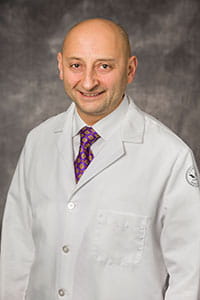Meeting the CAD Challenge
August 17, 2016
New Coronary Clinic at UH Harrington Heart & Vascular Institute offers combined approach for complex cases
Harrington Heart & Vascular Institute Innovations - Summer 2016 - View Full PDF
 Hiram Bezerra, MD, PHD
Hiram Bezerra, MD, PHD Yakov Elgudin, MD, PHD
Yakov Elgudin, MD, PHD
Multidisciplinary approaches to managing coronary artery disease (CAD) are relatively rare.
“Patients are typically referred either to surgery or to percutaneous coronary intervention (PCI),” says Hiram Bezerra, MD, PhD, a Co-Director, Cardiovascular CT and MRI Center, and Co-Director, Coronary Clinic, UH Harrington Heart & Vascular Institute; Assistant Professor of Medicine, Case Western Reserve University School of Medicine, “That’s the model for 99 percent of hospitals.”
According to Dr. Bezerra, this model is long overdue for disruption. He and UH cardiac surgeon Yakov Elgudin, MD, PhD, Co-Director, Aortic Disease Center, and Co-Director, Coronary Clinic, Center, UH Harrington Heart & Vascular Institute; Assistant Professor of Surgery, Case Western Reserve University School of Medicine are launching a new multidisciplinary Coronary Clinic at UH, with equal participation from surgeons and interventionalists. The goal is to create a deliberative process where all the best and most contemporary options for revascularization are considered.
“For patients with more complex anatomy, it’s important to use all the resources available,” Dr. Elgudin says. “It’s not uncommon that cardiologists and surgeons will disagree about the management of patients. By pulling people together, we can discuss issues directly and make the best possible decisions, given all the available options possible in the setting of a high-level quaternary center.”
In evaluating patients, the Coronary Clinic team relies not only on clinical experience, but also on newer evidence-based tools that bring outcomes data into the mix.
“There’s a lot of evidence in the literature today suggesting that you can make some of these decisions in almost a quantitative way,” Dr. Bezerra says.He references the SYNTAX and clinical SYNTAX risk score models, which were developed to predict the risk of adverse events.
“These scoring systems address the complexity of anatomy for intervention,” Dr. Bezerra says. “Our team will not only entertain qualitative conversations, we’ll also be able to systematically score patients for surgical risk vs. PCI risk in a way that is more reproducible.”
Advanced services provided to patients within the Coronary Clinic include minimally invasive coronary surgery done through a small thoracotomy. “There’s a lot of emerging data regarding minimally invasive approaches to coronary revascularization,” Dr. Elgudin says. “One option is robotic surgery or PCI, which is routinely performed at UH.
Robotically assisted coronary artery bypass surgery can be done by procuring the left internal mammary artery (LIMA) graft using the robot, and then doing the direct LIMA-to-LAD anastomosis.These are options for higher-risk patients or patients who simply want a less invasive approach.”
Other leading-edge options available within the Coronary Clinic are approaches to chronic total occlusion (CTO) and protected PCI using the Impella LVAD to provide hemodynamic support. For percutaneous treatment of CTO, Dr. Bezerra uses a streamlined, methodical approach of advanced imaging evaluation to select the best strategy and leading-edge tools. "It really has become a subspecialty,” he says. “It’s not a matter of experience but specialization. Even highly experienced operators should consider referring patients to specialized CTO programs, because novel techniques have dramatically increased success rates of CTO interventions.”
Complex PCI procedures can now be performed with the safety of LV hemodynamic protection with the Impella device.
The catheter is advanced into the heart and connected to an external pump. It then aspirates blood from the left ventricle and releases it into the aorta, aiding the weakened heart muscle by increasing cardiac output.
“This is the high end of catheter-based therapy, and we are pleased to offer it to our most complex patients with CAD,” Dr. Bezerra says.
For more information about the new Coronary Clinic at UH or to refer a patient, please call Dr. Bezerra at 216-983-5746 or Dr. Elgudin at 216-844-3992 or 216-844-4004.
Tags:


